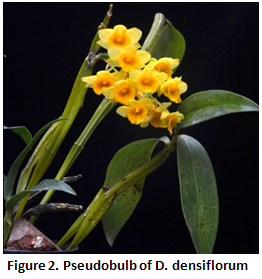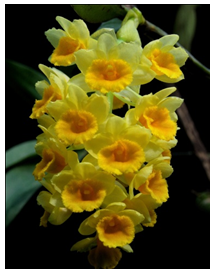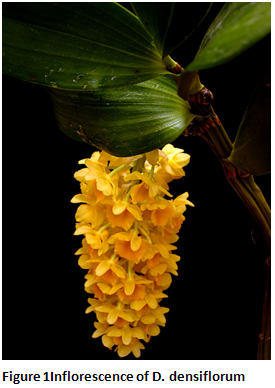Species of the Month
Dendrobium densiflorum Lindl.
Synonyms: Dendrobium clavatum Roxb., D. griffithianum var.guibertii (Carriere) Veitch.
This is a densely flowered Dendrobium and also known as Pineapple orchid because of the inflorescence resembling Pineapple. This is one of the most spectacular orchid species among the Dendrobiums. A popular species cultivated widely. It is easily identified by its cluster of flowers hanging down. This species is classified under section Callista. These are normally from mainland Asia with India, Myanmar, Thailand and Indochina being the major distribution pockets. In India, NE is the natural home of this species. Generally grows at an altitude of 1000 M as an epiphyte. In its natural habitat the seasonal conditions are distinct.
The pseudobulbs are 30 – 45 cm long, with several angles (distinguishing feature from D. farmeri) and about 2 cm in diameter. Persistent leaves numbering 3-5 remain on the pseudobulbs. The leaves are generally grouped at the apex.
Inflorescence is pendulous arising from the apex and has numerous flowers. Flowers are 3-5 cm across, yellow, with a rich orange lip and a hairy  top, fragrant and last for 1-2 weeks. Flowering is during the months of March, April.
top, fragrant and last for 1-2 weeks. Flowering is during the months of March, April.
Culture: The species prefers intermediate to cool growing conditions. They require bright light, preferably full morning sun and filtered one later. The plant has to be watered copiously during growth stage and after the current year growth switches to maturity, watering can be reduced.
For best flowering ensure that the plant has reached maturity to produce blooms. Ensuring production of new aerial roots is an important feature and will have good growth. The newly produced canes should be long.

Application of 19:19:19 on a weekly basis at half the recommended dose during growth period is advised. Application of organic fertiliser is also recommended.
The plants require high humidity and ensure a minimum of 50 percent. Under cultivation one can go for a well drained media of regular potting mixture of brickbats, charcoal and CHC. Staking is essential for bigger plants. The plant prefers hanging.
Species of the month by Dr. K. S. Shashidhar
The PDF version of the article can be downloaded here.
